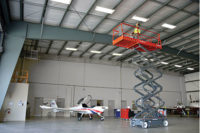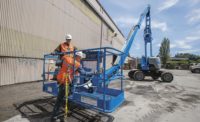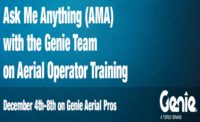Workers who install ceilings, drywalls, plaster, stucco and acoustics often use aerial work platforms to get materials and themselves to the required height. The AWP is quicker and easier to get to work than other forms of access, such as scaffolding, and allows the user to increase productivity and shorten project times that in-turn makes the operator more competitive.
AWP equipment is designed to safely lift personnel, along with their tools and materials, to positions where they can carry out work from the platform. AWP equipment provides one of the safest means to place workers at height to perform a task. Nonetheless, working at height has inherent risks that must be properly addressed to ensure the safety of workers. The benefits of AWP use means that they have become so common on job sites that it may be easy to forget that operating these machines requires training.
The first stage in the appropriate use of AWPs is the identification of work place hazards so that risks can be eliminated or controlled. A good source of information and recommended reading is a booklet, “Statement of Best Practices for Workplace Risk Assessment and Aerial Work Platform Equipment Selection”*. Here risk assessment is dealt with in detail, but Table 1 shows some examples of what the operator should be looking for.
Table 1 – Some of the hazards that can be associated with work involving AWP equipment.
- An untrained and/or non-familiarized operator
- Overhead obstructions during use
- Energized conductors, power lines or electrical hazards
- Other moving equipment or vehicles in the work area
- Obstructions during travel of the AWP equipment
- Overloading the platform
- Other personnel working in the same area
- Unusual operating conditions, e.g., on trucks, scaffolding, floating vessels, etc.
- Unauthorized use n Faulty or defective controls
- Inadequate ground support
- Ramps, decks and curbs
- Debris, such as tree branches, workplace materials, cords, etc.
- Drop-offs or holes, including those concealed by water, ice, mud, etc.
- Slopes
- Bumps and floor (ground) obstructions
- Wear, problems or malfunctions with the AWP equipment
- Wind and weather conditions
- Improper AWP equipment selection
- Hazardous environment, inadequate ventilation and/or excessive noise
- Inadequate lighting
The next stage is training in the actual use of AWP. According to the ANSI/SIA A92 Standards, when a user directs or authorizes an individual to operate an AWP, the user must ensure that the individual is trained before being assigned to operate it. The operator must receive general training on the type of AWP equipment being assigned. Instructions should include the inspection, application, recognition and avoidance of hazards associated with that equipment. Additionally, the operator must receive AWP equipment model-specific familiarization on the particular model that he/she will be operating. Both general training and familiarization are currently outlined in the ANSI/SIA Manuals of Responsibilities and the full ANSI/SIA A92 Standards.
The document “Statement of Best Practices of General Training and Familiarization for Aerial Work Platform Equipment” sets out full details**. It can be broadly split into General training and Familiarization.
General training is designed to prepare an operator to operate multiple pieces of equipment of a particular type: pusharound, boom lifts, scissor lifts, trailer-mounted boom lifts. This training usually takes the form of classroom-based information plus practical training using the equipment.
Table 2 – The basic requirements for General Training.
- The actual operation of the aerial platform “under the direction of a qualified person”
- The need for the trainee to operate the aerial platform(s) for a sufficient period of time to demonstrate proficiency in the actual operation of all functions of the aerial platform
- That much of the general training should take place in the classroom
- Regulations and standards
- The need to perform workplace inspections
- Recognition and avoidance of common hazards
- Operator warnings and instructions
- The purpose and use of manuals.
- A pre-start inspection
- Factors affecting stability
- Personal protective equipment
- General equipment components
- Safe use of equipment
- The proper selection of the AWP equipment for the job at hand
- The application and understanding of typical options that are likely associated with larger machines: e.g. outriggers/stabilizers, extendable axles, envelope management systems, load moment devices, dual capacity
Get Certified
Skyjack is a member and supporter of the International Powered Access Federation. IPAF is a not-for-profit members’ organization that promotes the safe and effective use of powered access worldwide. It represents the interests of manufacturers, distributors, users, rental and training companies, and serves as a forum for all active in the world of powered access. Those who successfully complete IPAF training are awarded the PAL Card (Powered Access License); the most widely held and recognized proof of training for AWP operators. The PAL Card is valid for five years and shows the machine categories that the operator has been trained in. It also features the holder’s photo and signature, and can be verified by calling IPAF. As one of the first North American registered IPAF training centers Skyjack can deliver this verifiable training to all AWP operators.
Familiarization is designed to prepare an operator to operate a specific model and takes place prior to use of that model. It is mostly practical in nature using the intended equipment and references the manufacturer’s recommendations as set out in the operator manual. The operator should receive instructions regarding the following items:
- The location of the weather resistant compartment for manual storage. It is the responsibility of the operator to ensure that the correct manuals are in fact on board the unit.
- The purpose and function of all controls.
- Safety devices and operating characteristics specific to the aerial platform.
Familiarization must be facilitated by a qualified person. Only a trained and qualified person may self-familiarize by reading and understanding the manufacturer’s operating instructions and user’s safety rules—or have it explained if there are questions. The familiarization process means that the manufacturer’s instructions are understood and complied with. A typical listing (in this cases based on Skyjack) is shown in Table 3.
Table 3 – Typical manufacturer’s topics – based on Skyjacks SJIII 3219 model operating manual.
- Component identification
- Visual and daily inspections
- Function tests
- Winching and towing procedures
- Emergency lowering procedures
Some operators having operated AWPs for years may think they do not require familiarization training. However, proper training can instill good habits and correct bad ones. New models enter the market with different characteristics and systems and only familiarization can highlight this. Training also offers information and skills that some operators may not have obtained through use of the equipment alone.
While the benefits of AWP use are clear, one has to remember that the primary purpose of AWP equipment is to provide personnel temporary access to work at height—work that may involve risk from potential workplace hazards. To increase the safe use of this equipment and reduce the risk associated with working at height training is the key. That training should cover the assessment and mitigation of risk combined with general training and familiarization of the specific machine to be used. The availability of IPAF’s PAL card meets that need for general training. Once trained, the operator can truly benefit from the employment of best practice and enjoy the economic and productivity benefits offered through the use of aerial work platforms.
References:
* Available at skyjack.com/sites/default/files/awp_bpra_1.pdf.
** Available at skyjack.com/sites/default/files/awp_bpg_2010-1_0.pdf.









Report Abusive Comment